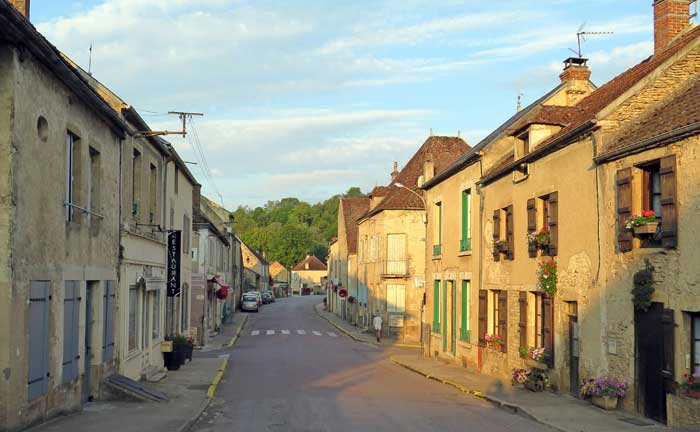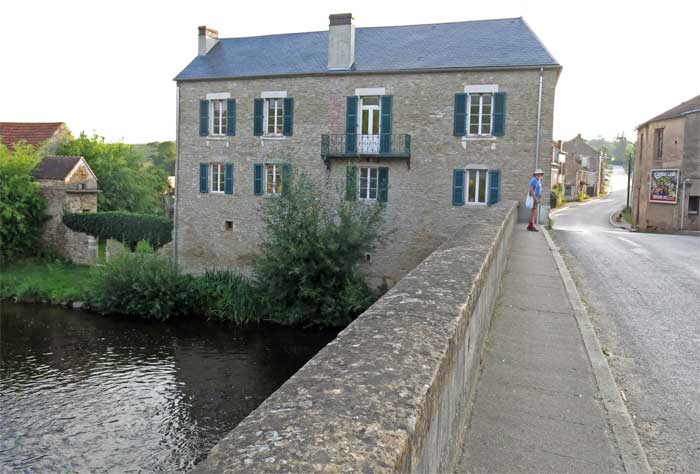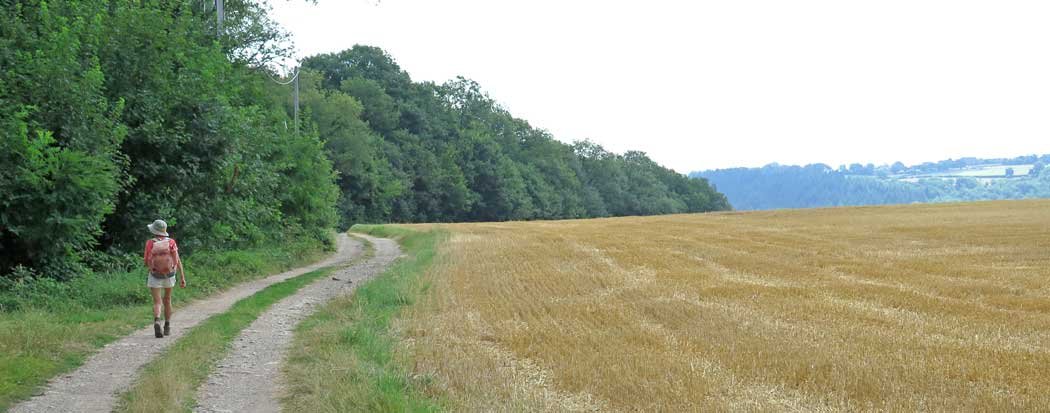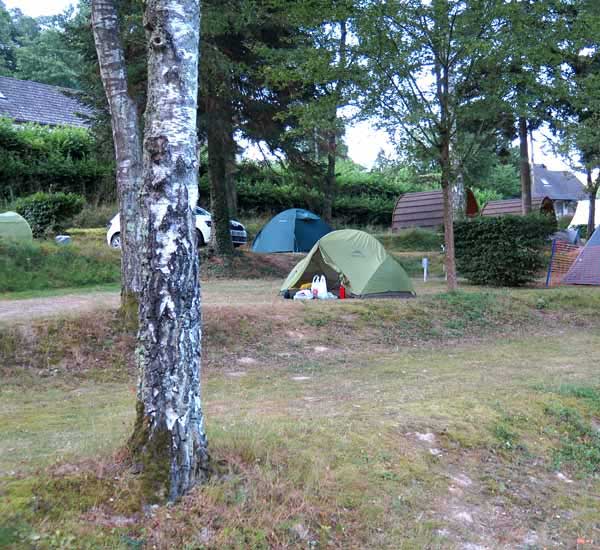
Tuesday, 17 July 2018
Distance 15 km
Duration 4 hours 0 minutes
Ascent 259 m, descent 215 m
We had asked at the bar the evening before, and discovered that they opened at 7 am, so we left the camping ground in time to arrive as the doors opened.
Naturally the camping ground was morgue-like at that hour, except for our Dutch cyclist neighbour, who was packing up to follow his heart homewards. We shook hands and wished each other well.

As we would be coming back past the camping ground, we left our packs leaning against a tree and walked in to the village unencumbered.
The bar was open, but to our amazement, the boulangerie was not – boulangeries usually open at the crack of dawn.
However, the baker was leaning in the doorway of his workroom, gazing down the street, and invited us in, saying that the shop itself would not be open for another half-hour.

Among the warm-smelling trays of breads and pastries, we selected what we wanted, paid and thanked our benefactor, then went to the bar next door for breakfast, and it was all entirely delightful, thanks to the friendly baker.

We were on our way by 7:30 am, crossing the river Cure for the last time and retrieving our packs from the camping ground.
The walk to Avallon was going to be almost a repeat of what we had done years before (2006), but that time we had got lost in the forest as we approached Avallon, and had ended up trudging down a road for a long way to reach the town. This time we were determined to do better.
We soon turned off the road and walked between flat, open fields on a wheel track.

The navigation was easy, as there were yellow marks all the way, but we had seen (on the map) a detour that would cut off a good kilometre of road-walking. When the yellow marks indicated a turn, we kept going straight ahead, wondering why the official way did not do the same. We found out a short time later, in the most painful possible way.
At first the track was good, with all the attributes of an old main road, with ancient hedges on both sides and the stony remnants of paving underfoot. Then, at the first bend, we were confronted by a wall of rampant blackberries, nettles and saplings. This was the moment to turn back, but we hate doing that, so we convinced ourselves that the blockage would not go on for long.
This was our big mistake – it went on for half a kilometre, and at every step the blackberry canes tore at our bare legs, while the nettles brushed their stinging poison excruciatingly into our cuts.

We looked longingly at the open fields rising beyond the hedges on either side, but we could not get to them, as the hedges were full of barbed wire.
After an age the blackberries petered out and we found ourselves in a shallow, stony stream, which was still the old road, but in an infinitely preferable form.
Then there was a patch of open forest which we crossed before emerging with great relief onto a bitumen road.
We were now back on the yellow-marked way, and we made sure that we did not deviate again.
Blood was running down our legs from our many cuts, and the flies were crawling, but the worst thing was the intense stinging.
At one point we stopped and covered our legs in face cream in a vain attempt to ease the pain.
Having crossed more fields, and some properly maintained paths through thick vegetation, we came to the oddly-named village of le Grand Island, which looked anything but grand to our eyes.
It consisted of a single descending street and the only living soul that we saw was an apron-clad woman artist at the door of her work room, with whom we exchanged friendly greetings.
After that the track dropped to a stream and bounced straight up again.
We were now in the large deciduous forest where we had become lost last time, but by paying great attention to the signage we managed to get through it, and it was a beautiful flat, shady walk.
In three or four kilometres we came out of the trees, where we met a couple of walkers coming the other way.
They were horrified at the state of our legs, but we assured them that if they followed the yellow signs, they would not share our fate.
We came to a fast-descending road, but left it almost immediately to follow a gravel track, flanked on one side by a shaven wheatfield and on the other by a pine forest.
Suddenly the wheel track shrank to a path and dropped like a lead weight through the forest, depositing us on a bitumen road, full of cars, beside the river. Crossing a bridge, we found the turn-off to the camping ground and marched in.

It was as we remembered it – a flourishing expanse of well-kept lawns and flower beds, crowded with campervans and tents. There was even a swimming pool with a hundred shrieking kids in it. An endearing feature was a little herb garden among the flowers, with a sign saying “Servez-vous” – help yourself.
It was almost midday as we tried the door of the reception building, finding it locked. However there was someone sitting at the desk inside, gesturing angrily at us. We finally worked out that he wanted us to come in the side door, and when we did so, he announced that we were too late, and would have to come back at 3 pm.
Then with a great show of putting himself out, he agreed to take our money, but a driver’s licence would not suffice as identification – it must be a passport. The little tyrant then said that we were not permitted to put up a washing line, but had to use a rack.
We had met this phenomenon before at municipal camping grounds – the employee assuming the airs of a dictator – and kept smiling benignly while he listed all the prohibitions. Eventually he noticed our blood-streaked legs and calmed down a bit, allowing us to depart.
The section for small tents was on a terrace at the top, well shaded but somewhat scuffed by over-use. Before having showers, we took a photo of our legs, and afterwards they looked much better, but the stinging continued unabated for the rest of the day.

To our great surprise, the petty tyrant sent someone to our camp with a clothes rack, proving that he was more bluster than malice.
The hot afternoon passed under a tree, and I amused myself by sewing another patch on my disintegrating shorts, using a white handkerchief that I thought I could do without.
Then at about 6 pm we set off for town. This was not as easy as it sounds, because the town of Avallon is on a high spur above the river Cousin, and the roads twist about dramatically on their way to the top. However, we took an old walking path, first over a small rise, and then up a staircase of drastic steepness, which delivered us in short order to the end of the spur.
Here the ramparts of former centuries stood as staunchly as ever, with their watch towers like pepper-pots at the corners, but the great entrance way was now devoid of gates and we marched straight in.
After that the mediaeval walled street rose steadily, past a great sprawling church (St-Lazare) and then through an arched portal under the clock tower. Suddenly we were in a world of shops, bars and people, exactly where we wanted to be.

We sat down at a big bar on the corner of the central square, les Maréchaux, and ordered a small carafe of rosé, which was very expensive, as we had come to expect in this region flowing with wine. After that we decided to have dinner at the same place, as there were not many restaurants to choose from.
We fell into conversation with a fat, garrulous old woman from Paris at the next table, and her thin, quiet husband, Claude.
With the air of a duchess she cast the menu aside, summoned the head waiter and instructed him what to prepare for her, then proceeded to tell us more than we wanted to know about her medical conditions.

They were on their way to a therapeutic three weeks at Aix-les-Bains, but could not drive the whole way in one stage because of her knees and back.
Breaking into bad English, she claimed that she had used her command of English to travel all around the world, but not to Australia, of which she seemed to doubt the very existence – “C’est un pays de rêve!”

Meanwhile our dinner appeared, first a plate of mixed crudités and then a piece of steak with salad and frites, a standard French meal, but much appreciated by us after not having eaten anything since breakfast in St-Père.

On the way back to the camping ground we had a bird’s eye view of the rooftops of the lower town as we picked our way back down the path, a route that we would return on in the morning.
We were looking forward to tomorrow, our first rest day for this year.
It would be not so much a rest day as a travel day, getting a train to whisk us over to Tonnerre on the Canal of Burgundy, so that we could walk the remaining two days to the end of the canal and finish our year’s walk in Auxerre.




